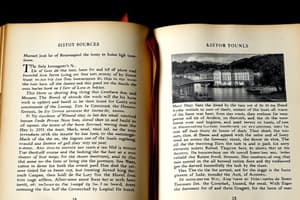Podcast
Questions and Answers
What is the main difference between primary and secondary sources?
What is the main difference between primary and secondary sources?
- Primary sources are firsthand accounts, whereas secondary sources analyze or interpret those accounts. (correct)
- Primary sources offer opinions, while secondary sources present facts.
- Primary sources are rewritten by scholars, while secondary sources are original documents.
- Primary sources consist of only written documents, while secondary sources consist of only visual materials.
Which of the following is considered a primary source?
Which of the following is considered a primary source?
- A documentary film summarizing World War II
- A history textbook analyzing events of World War II
- An oral history interview with a World War II veteran (correct)
- An article discussing the themes of World War II
Which classification includes materials like travelogues and speech transcripts?
Which classification includes materials like travelogues and speech transcripts?
- Published materials (correct)
- Artifacts
- Manuscripts
- Non-written sources
Images as a classification of primary sources are defined as:
Images as a classification of primary sources are defined as:
Which of the following statements accurately describes secondary sources?
Which of the following statements accurately describes secondary sources?
Published materials include items such as books, magazines, and ______.
Published materials include items such as books, magazines, and ______.
Manuscripts are typically ______ or typed records that have not been printed.
Manuscripts are typically ______ or typed records that have not been printed.
Non-written sources encompass oral history, ______, ruins, and artworks.
Non-written sources encompass oral history, ______, ruins, and artworks.
Primary sources are materials produced by individuals or groups directly ______ in the event.
Primary sources are materials produced by individuals or groups directly ______ in the event.
Written sources must be created by a firsthand ______ or participant.
Written sources must be created by a firsthand ______ or participant.
Images, as primary sources, serve as visual documents created by ______.
Images, as primary sources, serve as visual documents created by ______.
Artifacts are materials made by firsthand ______ of the event.
Artifacts are materials made by firsthand ______ of the event.
Oral testimonies document ______ conversations written or published by eyewitnesses.
Oral testimonies document ______ conversations written or published by eyewitnesses.
Secondary sources analyze and interpret ______ sources, including histories and periodicals.
Secondary sources analyze and interpret ______ sources, including histories and periodicals.
Flashcards are hidden until you start studying
Study Notes
Historical Sources Overview
- Historical sources are materials utilized for writing history, essential for research and analysis.
- Sources are classified into published materials, manuscripts, and non-written sources.
Classifications of Historical Sources
-
Published Materials:
- Includes books, magazines, journals, travelogues, and speech transcripts.
- Accessible to the public and often peer-reviewed.
-
Manuscripts:
- Consist of handwritten or typed documents that remain unpublished.
- Examples include archival records, memoirs, and personal diaries.
-
Non-Written Sources:
- Encompass oral histories, artifacts, ruins, fossils, artworks, and audio/video recordings.
- Provide context and tangible evidence of historical events.
Primary Sources
- Primary sources consist of original materials produced by individuals or groups directly involved in an event or subject.
- Types of primary sources include:
- Written Sources: Documents authored by firsthand witnesses or participants.
- Images: Visual records created or recorded by observers.
- Artifacts: Physical objects made by participants during the historical period.
- Oral Testimonies: Documented accounts of conversations from eyewitnesses or participants.
Secondary Sources
- Secondary sources analyze and interpret primary sources, offering synthesized insights.
- Typically found in formats like history books, serials, and periodicals.
- May include quotes, images, or statistics derived from primary materials to support analysis.
Historical Sources Overview
- Historical sources are materials utilized for writing history, essential for research and analysis.
- Sources are classified into published materials, manuscripts, and non-written sources.
Classifications of Historical Sources
-
Published Materials:
- Includes books, magazines, journals, travelogues, and speech transcripts.
- Accessible to the public and often peer-reviewed.
-
Manuscripts:
- Consist of handwritten or typed documents that remain unpublished.
- Examples include archival records, memoirs, and personal diaries.
-
Non-Written Sources:
- Encompass oral histories, artifacts, ruins, fossils, artworks, and audio/video recordings.
- Provide context and tangible evidence of historical events.
Primary Sources
- Primary sources consist of original materials produced by individuals or groups directly involved in an event or subject.
- Types of primary sources include:
- Written Sources: Documents authored by firsthand witnesses or participants.
- Images: Visual records created or recorded by observers.
- Artifacts: Physical objects made by participants during the historical period.
- Oral Testimonies: Documented accounts of conversations from eyewitnesses or participants.
Secondary Sources
- Secondary sources analyze and interpret primary sources, offering synthesized insights.
- Typically found in formats like history books, serials, and periodicals.
- May include quotes, images, or statistics derived from primary materials to support analysis.
Studying That Suits You
Use AI to generate personalized quizzes and flashcards to suit your learning preferences.




